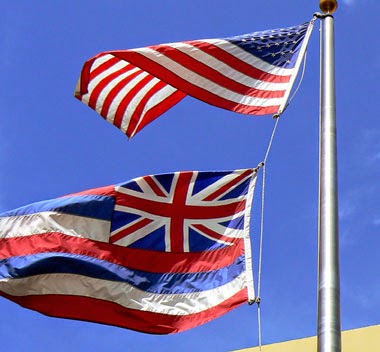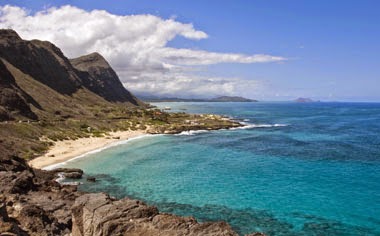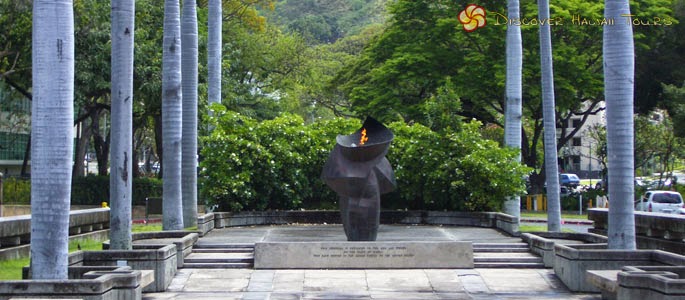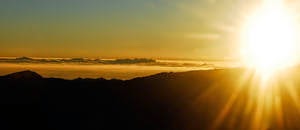Hawaii, the Aloha State
"For me its balmy airs are always blowing, its summer seas flashing in the sun; the pulsing of its surf is in my ear; I can see its garlanded crags, its leaping cascades, its plumy palms drowsing by the shore, its remote summits floating like islands above the cloud-rack; I can feel the spirit of its woody solitudes, I hear the plashing of the brooks; in my nostrils still lives the breath of flowers that perished twenty years ago."
- Mark Twain, a Biography
The official "Popular Name" of Hawaii is The Aloha State, which was designated in 1959 by the Legislature of the State. Hawaii has also been referred to as The Pineapple State because of the pineapple industry and its impact on the state's economy. Of course, anyone who has ever visited a secluded cove on one of the Hawaiian islands will understand why Hawaii is sometimes called the Paradise of the Pacific.
Hawaii is home of the world's most active volcano, the crater of Kilauea on Mauna Loa. Sandy beaches, towering volcanoes, and lush valleys lure thousands of tourists each year to this tropical paradise. The last state to enter the union, Hawaii is sometimes referred to as The Youngest State. The natural beauty of the islands is well known making scenic Hawaii a photographer's paradise.
"Hawaii" is possibly based on the native Hawaiian word for homeland (Owhyhee). Captain James Cook discovered the islands in 1778 and named the group "the Sandwich islands" (in honor of the Earl of Sandwich). This name lasted until King Kamehameha I united the islands under his rule in 1819 as the "Kingdom of Hawaii." The official state motto of Hawaii is: "Ua Mau ke Ea o ka 'Āina i ka Pono" (Hawaiian for The life of the land is perpetuated in righteousness).
Burning endlessly in remembrance of the December 7, 1941 attack on Pearl Harbor, the Eternal Flame Memorial stands just across the street from the Hawaii State Capitol Building. A walk through this memorial lends a quiet, contemplative mood to any visitor. It's an escape from the bustle of Downtown Honolulu and a tribute to the brave men and women who served in the Armed Forces of the United States. Built in 1944 exactly three years after the Pearl Harbor attacks which launched the United States into World War II.
Join us on a non-stop journey by air over our nation's most exotic and breathtaking state. From lush green cliffs to black-sand beaches, from ancient ruins to modern city life, this aerial tour reveals the grandeur of the Aloha State. From Molokai to Maui, discover the stunning landscapes and astonishing stories of Hawaii's eight major islands without ever touching the ground.
For many Native Hawaiians, the manner in which Hawaii became a US territory is a bitter part of its history. President Dwight D. Eisenhower signed the Hawaii Admission Act on March 18, 1959 which allowed for Hawaiian statehood. After a popular referendum in which over 93% voted in favor of statehood, Hawaii was admitted as the 50th state on August 21, 1959. Hawaii was subject to cultural and societal repression during the territorial period and the first decade of statehood. Along with other self-determination movements worldwide the 1960s Hawaiian Renaissance led to the rebirth of Hawaiian language, culture and identity.
Hawaii is the northernmost island group in Polynesia,
occupying most of an archipelago in the central Pacific Ocean.
occupying most of an archipelago in the central Pacific Ocean.
 |
Hawaii state flag flying with U.S. flag; photo by Tetsuya Odaka on Flickr
|
"Hawaii's state flag resembles the Union Jack of Great Britain because many of King Kamehameha's advisors were British and the islands were once placed under England's protection.
The flag consists of eight horizontal stripes, representing the eight major islands, and the British Union Jack. It has served as the flag of the kingdom, republic, territory, and the state of Hawaii. "
The nene, or Hawaiian goose was designated the official state bird of Hawaii in 1957. The nene seldom swims and is not bothered by predators or cold temperatures, so they do not fly as much and their wings are weak compared to other geese. Today the Nene has feet that are only half as webbed as other geese, and longer toes for climbing on the rocky Hawaiian surfaces. This unique bird is endangered.
The pua aloalo, or yellow hibiscus (Hibiscus brackenridgei) was designated the official state flower of Hawaii in 1988 (also called ma`o-hau-hele).
Hawaii designated surfing as the officail state individual sport in 1998 (outrigger canoe paddling was adopted as the official Hawaii team sport in 1986).
For all State Symbols of Hawaii click HERE!
A presence of life force
The Aloha Spirit doth impart
Emoting good feelings
Together of mind and heart
Kindness and tenderness
Go hand-in-hand
Like matchless echoes
Throughout the land
Unity within harmony
Adds splendor to sunlit days
With shadows of moonlit nights
With shadows of moonlit nights
Only present to amaze
Pleasant agreement
Burns from within
Touching others with gladness
Little or no chagrin
Humility with modesty
Looks inward to the self
Outward-looking to others
Along a parallel shelf
Along a parallel shelf
Power of patience
Pairs with perseverance
Thwarting the obstacles
In spite of appearance
Traits of character
Traits of character
Hawaiian people bear
Charm, warmth, sincerity
Each heartily declare
©2014 Sharla Lee Shults
| Island Shape and Mountain Orientation |










No comments:
Post a Comment